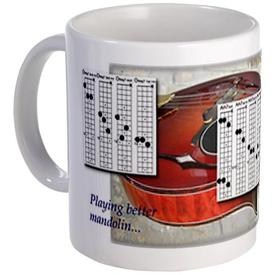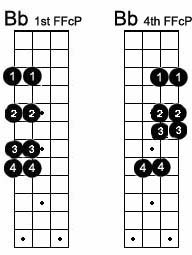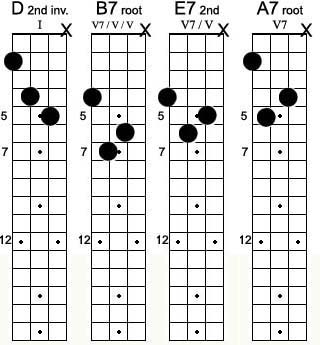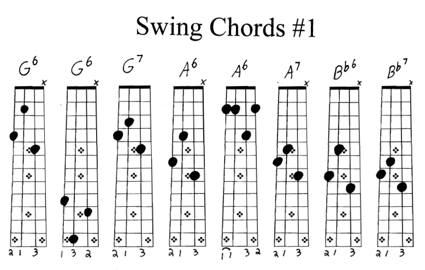« November 2012 |
Main
| January 2013 »
 December 27, 2012 | Best of JM: More m7b5 (from the Pros!)
December 27, 2012 | Best of JM: More m7b5 (from the Pros!)
Enjoy the popular archive material below.
From March 12, 2009 | More m7b5 (from the Pros!)
We promised this last week, so here we go. Some of our favorite Jazz Mandolin professionals weighed in with their stock m7b5 Stock Chords. Remember, these "grips" can easily be moved up and down the fingerboard, so try moving them up and down a couple frets at first. Develop your transposition skills further by going even higher up the fretboard for even more versatility; nothing like being able freshen 30 chorus of comping with multiple variations of the chords. Next step is to put them in context with a subsequent V7 chord, but we'll leave that for some other time.
Here're three from Texas Swingmaster Paul Glasse:
  
Two more by Paul he says he uses less frequently (a little more awkward), and a third chopbuster from Bruce Clausen. These are probably not "quick change artist" chords, but might be useful depending on song tempo and what comes before and/or after:
  

Will Patton throws in this strange one on the right, but again, one with the capacity to move up the fretboard.
We mentioned "context" and two different artists explored three-note chord versions that left out one of the chord voices, which is a very common thing to do in comping. (Good to learn these variations if you ever want to get into 5-string playing.) Bear in mind, using your lower three courses in comping can give you a chunkier percussive "crunch" to your chording.
The first is from Chicago jazzmaster, Don Stiernberg who opted to drop the minor 7th (keeping the root), which gives him a voice leading E into an E# on a Dominant chord variation A7Aug. Again, context is everything:
 
West Coast fiddler/mandolinist extraordinare, Pete Martin uses 7th (no root) and migrates to the V7 chord with a voice leading of D to C#. Then, he follow with an intriguing resolution to a Minor chord with a Maj 7th):
  .jpg)
Have some fun learning these. If transposition is not your thing yet, feel free to download our FretboardTemplate and write these out for your own library. Sometimes physically writing them out can be a way of integrating them into your memory, both muscle and brain.
Further:
m7b5 Chords
Jazzed Pentatonics
Mark Wilson's Grips
Mandolin Cafe discussion
Posted by Ted at 6:59 AM
 December 20, 2012 | Best of the year 2012: Tips and Tricks
December 20, 2012 | Best of the year 2012: Tips and Tricks
We did some reorganizing on the site this summer, some index refreshing and general housecleaning, but we wanted to take the time in December to review highlights from our weekly Tips and Tricks 2012 column. We think these are some of the best we've offered!

In January we explored a specific intellectual ingredient the concept of theory vs. intuition in improvising. There's a continuum in the approach to how to create melody starting on one side with calculation of formulaic scales, modes and arpeggios and reaching the other side with blind, reckless intuitive spontaneity (just blow), and we looked at the notion of notes that set up the harmonic structure in short passages we call "Turnarounds," including a transposable PDF Exercise . The next month we broaden the art of improvising mapping the "tell a story" approach to creating a better approach in Building a solo .
March gave us a peak at Left hand techniques, a review on Chord economy, and even more thoughts on The Muse Continuum--Improvisation and Inspiration. We started the second quarter with a retrospective on thoughts from the late John McGann, and a review of our own FFcP studies and strategies .

We tried to understand how basic music theory concepts would make understanding music faster and more effiecient in May's Complexity leads to simplicity, and later in the month explained Why is an E# not just an F. June began a closer look at applying inversions of 3-note 7th chords in real life .

Sadly, 2012 was the end of our nine year tenure with the now defunct Mel Bay Mandolin Sessions . We took the time to digest many of the cool tricks in our articles of Tips on improvising from the Pros . In late June we added to our FFcP library of exercises with two articles on Two Octave FFcP , including a two page
Two Octave FFcP PDF.

We took some time to apply some analysis and FFcP patterns to two classic jazz standards, Bluestte and xxxx. The proof is in the pudding as they say, more appropriately in this case, the put-ing.
Arguably our crowning glory was our series on Vamps in which we mapped out some common 3-note comping patterns you can apply to a myriad of tunes. If you do nothing else on the site, at least make sure to dig into these. Amaze and impress your fellow musicians:
Vamps Pt 1. Creating energy with Diatonic triads
Vamps Pt 2. Expanding the Diatonic triads
Vamps Pt 3. Scurry Dominants
Vamps Pt 4. Circle of fifths
Vamps Pt. 5 Minor Modal
These were even placed into permanent history as a Lesson Archive at the Mandolin Cafe

Along the same lines was our series on 7th Chord Streams, Major and Minor. If you haven't already, be sure to print out the two page PDFs of the chords there. They are especially good for the 5-string mandolinist or tenor guitar/mandolaist.
It was a great year and we look forward to new stuff we'll bring you for 2013!
Posted by Ted at 3:27 PM
 December 13, 2012 | Lesson Hub from Mandoberlin
December 13, 2012 | Lesson Hub from Mandoberlin
We mentioned the solo recording project Oregon fret master Brian Oberlin earlier this week, and have had several readers give us positive feedback about his spring River of the West Mandolin camp series, (now in its fifth season). What you may not be aware of is the free resources in the "Lesson Hub" on his website, including song TABs, chord charts, scale exercises, and rich assortment of genre diversity.
The library of information is bite-size and applicable to many skill levels. You can download as many as you can digest, and print for later discovery. If you can't make it to Oregon for one of his camps, this is the next best thing.

Also, we're looking forward to bringing you some guest articles from Brian in 2013.
Here are links to some samples:
Swing Chords #1
Swing Chords #2
Full site: Mandoberlin

Posted by Ted at 12:19 PM
 December 6, 2012 | Mandolin considerations. Jazz vs. Bluegrass
December 6, 2012 | Mandolin considerations. Jazz vs. Bluegrass
The similarities between playing bluegrass and jazz are plentiful. You state the melody of the tune, the rest of the ensemble takes turns making melodies over the chord structure, and end with a restatement of the tune. You have musicians trading and sharing duties of accompaniment, and there's a ying and yang of experimentation but keeping the group together in a collective whole.
That said, there are significant variations in character in jazz that though nuanced, are important considerations for a mandolinist sitting in with the more traditional jazz settings, especially if you intended to hang with drum set, piano, bass, and guitar, let alone the jazz signature wind instruments like sax, trumpet, and trombone. You need to know these to adjust and adapt your playing to blend in with these environments.

Comping (register & percussiveness). The mandolin is high in register and typically percussive. This works great in the bluegrass world where the mandolin is the backbeat "time keeper." Beats 2 and 4, it punctuates the music like a hihat cymbal, and that's great, unless you're playing with a hihat cymbal. Be sensitive to the percussiveness of your pick, and if all you're playing is just chords, it's a good idea to slow your rhythms down, simplify rather than compete, and stick to your lower strings. If you keep it in this register, you're not fighting the chord extensions of the rhythm section. Less is more.
Articulations (upstroke vs. downstroke). Bluegrass picking is all about power downstrokes, and there's a legitimate reason why. Folk music unamplified called for heavy articulation in order to be heard above all the other players. In the more subtle world of jazz, there's more need for nuance, and a healthy upstroke can give you more swing. Think Sinatra "Doo BEE Doo BEE" swing when you pick and pull more meat out of your upstroke with these rhythms and you make significant progress in sounding like a true jazzer. (Gypsy jazz might be an exception to this, but that's a topic for another time)
Tone (emphasis on line and phrasing over speed). Lightning picking speed is a hallmark of a good bluegrass mandolinist, but in jazz you need to trade this for tonal character. The motorboat picking style is nails on a chalkboard in the jazz circle. You want rich, intentional tone, vibrant string tone to communicate line. You also need to think in phrases rather than licks. Make sentences with your music, not spew giberish.
Language (pentatonic vs. harmonic direction). Of course the jazz language is infinitely more complex. Rarely straying from a 'I IV V' progression, let alone more than a couple keys, the jazzer must be adept at all 12 keys, and a harmonic cafeteria filled with 'ii V7 I' and 'ii7b5 V7 i' progression--sometimes all in the same phrase! The richness in harmonic extensions, b9, +4, 13th, call for tones that go well outside the pentatonic scale. Nothing more irritating than a mandolinist that blurts nothing but pentatonic riffs in a harmonically fluid jazz standard.
These are all important to keep in mind as you make the journey to jazz purity. The mandolin is wide open to traveling a new frontier, but you need the right approach and the equipment to travel it well.
Further
Approaching Improvisation
Advanced Pentatonic
4 and 7. The Committal Notes.
Playing musically: Part 4, play with maximum tone
Posted by Ted at 2:10 PM

Disclaimer: In the 'Information Age' of the 21st Century,
any fool with a computer, a modem, and an idea can
become a self-professed 'expert." This site does not
come equipped with 'discernment.'
|



